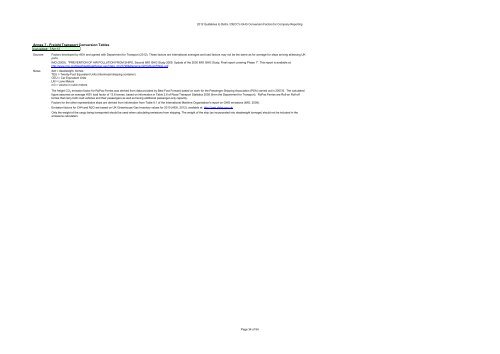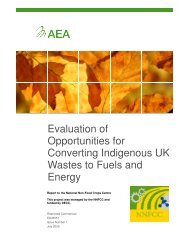Greenhouse gas conversion factors for company reporting
Greenhouse gas conversion factors for company reporting
Greenhouse gas conversion factors for company reporting
You also want an ePaper? Increase the reach of your titles
YUMPU automatically turns print PDFs into web optimized ePapers that Google loves.
2012 Guidelines to Defra / DECC's GHG Conversion Factors <strong>for</strong> Company Reporting<br />
Annex 7 - Freight Transport Conversion Tables<br />
Last updated: Apr-12<br />
Sources<br />
Notes<br />
Factors developed by AEA and agreed with Department <strong>for</strong> Transport (2012). These <strong>factors</strong> are international averages and load <strong>factors</strong> may not be the same as <strong>for</strong> average <strong>for</strong> ships arriving at/leaving UK<br />
ports.<br />
IMO (2009). "PREVENTION OF AIR POLLUTION FROM SHIPS, Second IMO GHG Study 2009. Update of the 2000 IMO GHG Study, Final report covering Phase 1". This report is available at:<br />
http://www.imo.org/blast/blastDataHelper.asp?data_id=27795&filename=GHGStudyFINAL.pdf<br />
dwt = deadweight, tonnes<br />
TEU = Twenty-Foot Equivalent Units (intermodal shipping container)<br />
CEU = Car Equivalent Units<br />
LM = Lane Meters<br />
m3 = volume in cubic meters<br />
The freight CO 2 emission factor <strong>for</strong> RoPax Ferries was derived from data provided by Best Foot Forward based on work <strong>for</strong> the Passenger Shipping Association (PSA) carried out in 2007/8. The calculated<br />
figure assumes an average HGV load factor of 13.6 tonnes, based on in<strong>for</strong>mation in Table 2.6 of Road Transport Statistics 2005 (from the Department <strong>for</strong> Transport). RoPax Ferries are Roll-on Roll-off<br />
ferries that carry both road vehicles and their passengers as well as having additional passenger-only capacity.<br />
Factors <strong>for</strong> the other representative ships are derived from in<strong>for</strong>mation from Table 9.1 of the International Maritime Organisation's report on GHG emissions (IMO, 2009).<br />
Emission <strong>factors</strong> <strong>for</strong> CH4 and N2O are based on UK <strong>Greenhouse</strong> Gas Inventory values <strong>for</strong> 2010 (AEA, 2012), available at: http://naei.defra.gov.uk/<br />
Only the weight of the cargo being transported should be used when calculating emissions from shipping. The weight of the ship (as incorporated into deadweight tonnage) should not be included in the<br />
emissions calculation.<br />
Page 34 of 54








